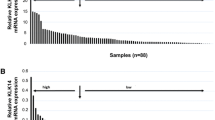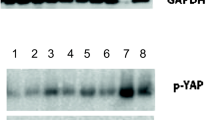Abstract
Dipeptidyl peptidase 9 (DPP9) was recently identified as fusion gene in ovarian high-grade serous carcinoma (HGSC). The aim of this study was to analyze the expression and clinical relevance of DPP8 and DPP9 in ovarian carcinoma, with focus on HGSC. mRNA expression by qRT-PCR of DPP8 and DPP9 was analyzed in 232 carcinomas, including 114 effusions and 118 surgical specimens (89 ovarian, 29 solid metastases). DPP8 and DPP9 protein expression was analyzed in 92 effusions. DPP8 and DPP9 mRNA was overexpressed in effusions compared to solid lesions in analysis of all histotypes (p < 0.001 both), as well as in analysis limited to HGSC (p < 0.001 for DPP9, p = 0.002 for DPP8). DPP9 mRNA was additionally overexpressed in HGSC compared to other histotypes (p = 0.021). DPP8 and DPP9 protein was expressed in carcinoma cells in 31/92 (37%) and 81/92 (88%) effusions, respectively. DPP8 protein expression in HGSC effusions was significantly related to better (complete) chemoresponse at diagnosis (p = 0.005). DPP8 and DPP9 mRNA and protein expression was unrelated to survival in analysis of the entire effusion cohort. However, higher DPP9 mRNA levels were significantly related to longer overall survival in pre-chemotherapy effusions (p = 0.049). In conclusion, DPP8 and DPP9 mRNA is frequently expressed in ovarian carcinoma, whereas DPP9 is more frequently expressed at the protein level. DPP8 and DPP9 may be related to less aggressive disease in advanced-stage HGSC.




Similar content being viewed by others
References
Reid BM, Permuth JB, Sellers TA (2017) Epidemiology of ovarian cancer: a review. Cancer Biol Med 14:9–32
Torre LA, Trabert B, DeSantis CE, Miller KD, Samimi G, Runowicz CD, Gaudet MM, Jemal A, Siegel RL (2018) Ovarian cancer statistics. CA Cancer J Clin 68:284–296. https://doi.org/10.3322/caac.21456
Davidson B (2018) Ovarian carcinoma. In: Davidson B, Firat P, Michael CW (eds) Serous effusions - etiology, diagnosis, prognosis and therapy, 2nd edn. Springer, London
Kurman RJ, Carcangiu ML, Herrington CS, Young RH (2014) WHO classification of tumors of female reproductive organs. IARC, Lyon
Davidson B (2016) Recently identified drug resistance biomarkers in ovarian cancer. Expert Rev Mol Diagn 16:569–578
Pitman MR, Sulda ML, Kuss B, Abbott CA (2009) Dipeptidyl peptidase 8 and 9--guilty by association? Front Biosci (Landmark Ed) 14:3619–3633
Zhang H, Chen Y, Keane FM, Gorrell MD (2013) Advances in understanding the expression and function of dipeptidyl peptidase 8 and 9. Mol Cancer Res 11:1487–1496
Zhang H, Maqsudi S, Rainczuk A, Duffield N, Lawrence J, Keane FM, Justa-Schuch D, Geiss-Friedlander R, Gorrell MD, Stephens AN (2015) Identification of novel dipeptidyl peptidase 9 substrates by two-dimensional differential in-gel electrophoresis. FEBS J 282:3737–3757
Smebye ML, Agostini A, Johannessen B, Thorsen J, Davidson B, Tropé CG, Heim S, Skotheim RI, Micci F (2017) Involvement of DPP9 in gene fusions in serous ovarian carcinoma. BMC Cancer 17:642
Hoogstraat M, de Pagter MS, Cirkel GA, van Roosmalen MJ, Harkins TT, Duran K, Kreeftmeijer J, Renkens I, Witteveen PO, Lee CC, Nijman IJ, Guy T, van 't Slot R, Jonges TN, Lolkema MP, Koudijs MJ, Zweemer RP, Voest EE, Cuppen E, Kloosterman WP (2014) Genomic and transcriptomic plasticity in treatment-naive ovarian cancer. Genome Res 24:200–211
Fu J, Bian L, Zhao L, Dong Z, Gao X, Luan H, Sun Y, Song H (2010) Identification of genes for normalization of quantitative real-time PCR data in ovarian tissues. Acta Biochim Biophys Sin Shanghai 42:568–574
Livak KJ, Schmittgen TD (2001) Analysis of relative gene expression data using real-time quantitative PCR and the 2(-Delta Delta C(T)) Method. Methods 25:402–408
Wilson CH, Abbott CA (2012) Expression profiling of dipeptidyl peptidase 8 and 9 in breast and ovarian carcinoma cell lines. Int J Oncol 41:919–932
Yao TW, Kim WS, Yu DM, Sharbeen G, McCaughan GW, Choi KY, Xia P, Gorrell MD (2011) A novel role of dipeptidyl peptidase 9 in epidermal growth factor signaling. Mol Cancer Res 9:948–959
Tang Z, Li J, Shen Q, Feng J, Liu H, Wang W, Xu L, Shi G, Ye X, Ge M, Zhou X, Ni S (2017) Contribution of upregulated dipeptidyl peptidase 9 (DPP9) in promoting tumoregenicity, metastasis and the prediction of poor prognosis in non-small cell lung cancer (NSCLC). Int J Cancer 140:1620–1632
Kajiyama H, Kikkawa F, Khin E, Shibata K, Ino K, Mizutani S (2003) Dipeptidyl peptidase IV overexpression induces up-regulation of E-cadherin and tissue inhibitors of matrix metalloproteinases, resulting in decreased invasive potential in ovarian carcinoma cells. Cancer Res 63:2278–2283
Kajiyama H, Shibata K, Ino K, Mizutani S, Nawa A, Kikkawa F (2010) The expression of dipeptidyl peptidase IV (DPPIV/CD26) is associated with enhanced chemosensitivity to paclitaxel in epithelial ovarian carcinoma cells. Cancer Sci 101:347–354
Mhawech-Fauceglia P, Yan L, Sharifian M, Ren X, Liu S, Kim G, Gayther SA, Pejovic T, Lawrenson K (2015) Stromal expression of fibroblast activation protein alpha (FAP) predicts platinum resistance and shorter recurrence in patients with epithelial ovarian cancer. Cancer Microenviron 8:23–31
Funding
This work was supported by The Inger and John Fredriksen Foundation for Ovarian Cancer Research. Marta Brunetti is supported by a grant from the South-East Health Region of Norway.
Author information
Authors and Affiliations
Contributions
MB performed the PCR experiments and wrote the manuscript.
AH performed the IHC experiments.
IP participated in performing the PCR experiments and critically read the manuscript.
ACS provided clinical data and specimens and critically read the manuscript.
FM designed the study, supervised the PCR experiments, and critically read the manuscript.
BD designed the study, performed the statistical analysis, scored the immunostains, and supervised the writing of the manuscript.
Corresponding author
Ethics declarations
The study was approved by the Regional Committee for Medical Research Ethics in Norway.
Conflict of interest
The authors declare that they have no conflict of interest.
Rights and permissions
About this article
Cite this article
Brunetti, M., Holth, A., Panagopoulos, I. et al. Expression and clinical role of the dipeptidyl peptidases DPP8 and DPP9 in ovarian carcinoma. Virchows Arch 474, 177–185 (2019). https://doi.org/10.1007/s00428-018-2487-x
Received:
Revised:
Accepted:
Published:
Issue Date:
DOI: https://doi.org/10.1007/s00428-018-2487-x




